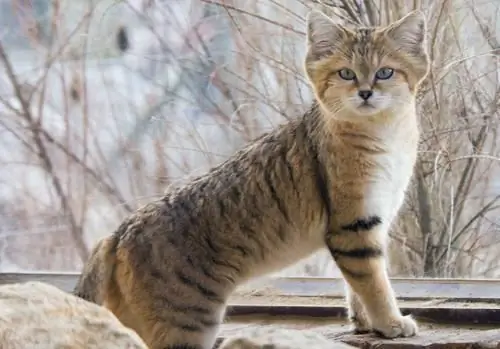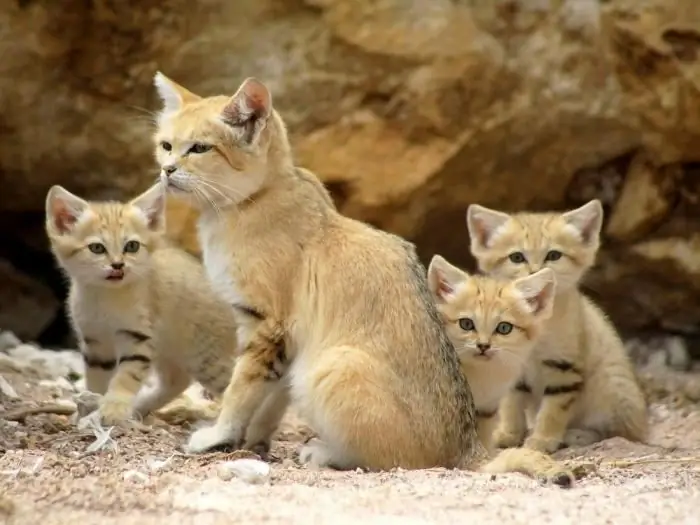2025 Author: Priscilla Miln | [email protected]. Last modified: 2025-01-22 17:55:21
The dune cat is a rare, one might say, an endangered species of representatives of the wild fauna. The main habitat of the sand cat, as it is also called, is the deserts of South Africa, Israel, Pakistan and the Asian regions of the post-Soviet space (Kazakhstan, Uzbekistan, etc.).
Outwardly, the dune cat is very similar to a domestic cat. But only at first glance it seems that he is cute and fluffy. In fact, this is a real and formidable predator.
What does it look like?

The main distinguishing feature of the sand cat can be called an interesting head shape. It resembles a flattened inverted triangle and seems to be elongated to the sides.
The ears are very similar to lynxes, although they do not have characteristic tassels.
No less interesting are the colors. Most often, cats have a sandy or light gray coat.
It is understandable, this color helps to disguise itself among the sandy landscape.
It is worth noting that the undercoat of the dune cat is very thick. It saves the animal from hypothermia during the desert nights, which can not be called hot.
Lifestyle

In nature, dune cats are nocturnal, so theyquite hard to see in person. They feed mainly on small rodents and reptiles that live in deserts: jerboas, lizards, and insects. By the way, these are the only animals that are not at all afraid of poisonous snakes and constantly hunt them. The favorite delicacy of the cat predator is the horned viper. Surprisingly, these animals practically do not need water. They get enough moisture from their victims.
Sand cats during the day from the sweltering heat hide in the old, destroyed holes of foxes, porcupines. Very rarely do they dig a shelter on their own.
Females give birth only once a year. There can be from one to five kittens in one litter. A rare case when eight newborns are born. It is known that keeping cats in captivity can lead to an increase in the number of estrus periods in females, and therefore they can bring offspring up to two or three times a year.
How many years cats live on free bread has not been studied. But it is well known that in captivity life expectancy is about fifteen years.
Sand cat - captivity

Recently, the demand for this amazing animal has increased among lovers of exotic animals. Despite the fact that the dune cat is under protection, this does not prevent poachers from catching and selling representatives of this species to ordinary people.
It is worth considering that sand cats are prone to various respiratory diseases, viral infections. Therefore, it is important for them tovaccination, as for ordinary domestic cats.
It must be remembered that low humidity and constant temperature are important for a comfortable existence. Only in this case will the dune cat please the new owner. The price of non-compliance with these conditions is the life of an exotic pet.
And, finally, the last thing - at home, without certain knowledge, it will not be possible to normally keep a sand cat. Therefore, for the sake of fun or bragging in front of friends and acquaintances, doom a beautiful, intelligent and cute animal to torment.
Recommended:
Black feces in a cat: causes and treatment. Cat food for sensitive stomach

The material tells about the causes of black feces in cats. When is it worth sounding the alarm, in what cases is there nothing to worry about? How to treat the disease? Is it worth contacting a veterinarian or is the treatment carried out at home? Answers to questions - in the article
What is cat food made of? Cat food review and composition comparison

What is cat food made of? Every owner of pet four-legged friends must have asked a similar question. The article is devoted to the answer to it. An overview of the most popular cat food will also be given
What kind of vision does a cat have - color or black and white? The world through the eyes of a cat

Let's consider what kind of vision a cat has, why it sees better in the dark than in the light, and in what colors cats see the world. Consider the main colors of the eyes of cats, and the features of their night hunting
Is cat food harmful: the opinion of veterinarians. Dry cat food: pros and cons

The article talks about the benefits and harms of dry cat food. Different categories of ready meals are considered
What is a sand ceremony at a wedding?

Wedding for every person is a very significant event in life. Usually it is preceded by a long preparation with the selection of formal attire, ordering a festive feast and a scenario for holding a memorable event

